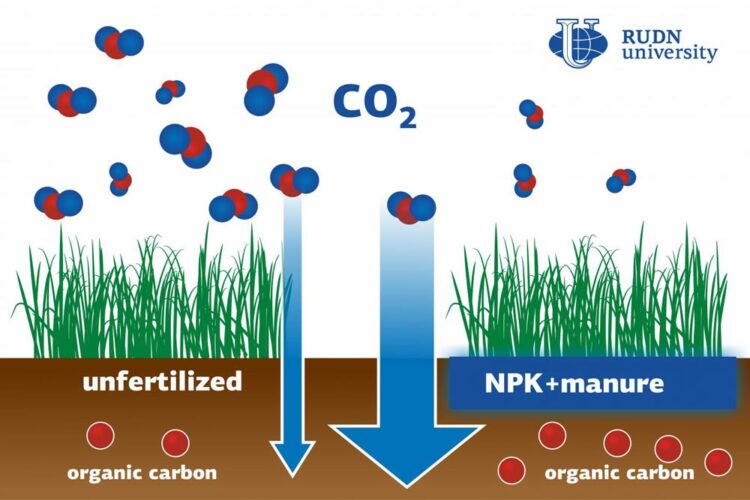Paddy soil fertilization can help reduce greenhouse effect

A soil scientist from RUDN University discovered the effect of fertilization on the ability of the soil to retain carbon. To understand this mechanism, he and his team studied the movement of organic carbon in the soil of rice paddies. The results of the study can help increase the fertility of the paddies while at the same time reducing the volume of greenhouse gases in the atmosphere.
Credit: RUDN University
A soil scientist from RUDN University discovered the effect of fertilization on the ability of the soil to retain carbon. To understand this mechanism, he and his team studied the movement of organic carbon in the soil of rice paddies. The results of the study can help increase the fertility of the paddies while at the same time reducing the volume of greenhouse gases in the atmosphere. An article about the study was published in the Soil Biology and Biochemistry journal.
The main reason for global climate change is the increasing amount of carbon dioxide in the atmosphere. CO2 prevents thermal emissions from leaving our planet, and the so-called greenhouse effect occurs. Being able to absorb up to 10% of carbon dioxide from the atmosphere (which amounts to approximately 20,000 megatons of carbon in 25 years), soils could mitigate this effect. A soil scientist from RUDN University studied the mechanism of carbon retention in the soils of rice paddies that account for 40% of natural atmospheric carbon absorption in China. According to him, the ability of the soil to retain carbon depends, among other factors, on its structure and the presence of fertilizers.
“The soils of rice paddies play an important role in mitigating the consequences of global warming and contribute a lot to the retention of carbon. The most effective way to study the processes that lead to the accumulation of organic carbon in the soil is to measure the concentration of its isotopes. We used this method to find out how mineral and organic fertilizers affect carbon flows between fractions of different density in rice paddy soils,” said Yakov Kuzyakov, the Head of the Center for Mathematical Modeling and Design of Sustainable Ecosystems at RUDN University.
The team studied three groups of soils with different types of fertilizers: azophoska, or nitrogen-phosphorus-potassium fertilizer, was added to the first group; the second one contained azophoska with straw, and the third–azophoska with organic supplements. The content of carbon in the soils and its movement between density fractions was determined based on the ratio of 13C and 12? isotopes. The second and the third group showed better carbon retention results: after fertilization, their carbon content grew by 69%, while the increase in the first group amounted to 30%.
The scientists also paid attention to the changes in soil structure under the influence of fertilizers and the effect of such changes on carbon retention. Fertilizers consolidate the structural elements of the soil, and the number of large soil particles (over 0.25 mm in diameter) grows. Soils of medium density showed the highest carbon retention efficiency after fertilization: the amount of accumulated carbon increased by 70% compared to unfertilized soils. Less dense soil fractions showed a 21-56% increase, and carbon retention in dust and clay grew by 24-49%.
“We confirmed that fertilizers support organic carbon retention in the soil. Knowing this, we could better understand the processes that lead to the accumulation of soil carbon in rice paddies. These agricultural ecosystems already play an important role in world food security and now can also help us combat climate change,” addedYakov Kuzyakov.
All latest news from the category: Earth Sciences
Earth Sciences (also referred to as Geosciences), which deals with basic issues surrounding our planet, plays a vital role in the area of energy and raw materials supply.
Earth Sciences comprises subjects such as geology, geography, geological informatics, paleontology, mineralogy, petrography, crystallography, geophysics, geodesy, glaciology, cartography, photogrammetry, meteorology and seismology, early-warning systems, earthquake research and polar research.
Newest articles

You are What You Eat—Stanford Study Links Fiber to Anti-Cancer Gene Modulation
The Fiber Gap: A Growing Concern in American Diets Fiber is well known to be an important part of a healthy diet, yet less than 10% of Americans eat the minimum recommended…

Trust Your Gut—RNA-Protein Discovery for Better Immunity
HIRI researchers uncover control mechanisms of polysaccharide utilization in Bacteroides thetaiotaomicron. Researchers at the Helmholtz Institute for RNA-based Infection Research (HIRI) and the Julius-Maximilians-Universität (JMU) in Würzburg have identified a…

ASXL1 Mutation: The Hidden Trigger Behind Blood Cancers and Inflammation
Scientists show how a mutated gene harms red and white blood cells. LA JOLLA, CA—Scientists at La Jolla Institute for Immunology (LJI) have discovered how a mutated gene kicks off…



